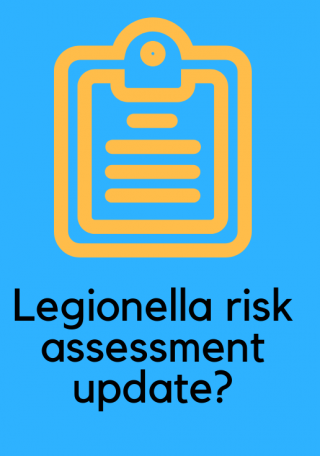When does a Legionella risk assessment need to be updated?

Keeping a legionella risk assessment current and up to date is a requirement under Health and Safety law. By following the 6 key indicators below you will know when an update is required, or if your risk assessment is current and valid and no further actions are required until the next review.
The ACoP L8 does not state a set timeframe for a legionella risk assessment to be updated, it is not a requirement to update it annually or biennially, as so often thought. The frequency of the update will depend on the risks associated with any given system defined in the risk assessment document and changes which effect it over time.
The risk assessment must be updated when the Duty holder reviews it and believes it is no longer current or valid. Depending on the risks associated with the system this could be years’ for a low risk property where nothing has changed, to much more regular updates for a high risk system.
A Dantek legionella risk assessment document will suggest a review date based on the risk factors identified, but should any of the following 6 changes occur in the meantime the risk assessment must be updated at that point.
Even for low risk properties where no further actions were required as a result of the risk assessment, the control measures put in place must be maintained and monitored to ensure they remain effective. The assessment of risk is therefore an ongoing process.
Duty holders must make arrangements to review the legionella risk assessment regularly and also if they believe it is no longer valid.
There are 6 key indicators to know when to review a legionella risk assessment. If any of the following occur then the risk assessment must be reviewed and any changes updated within the document.
6 key indicators to review a legionella risk assessment
1. The water system has been changed or is being used differently
2. The building use changes
3. New information becomes available about the risk or control measures
4. Monitoring indicates the control measures set out in the risk assessment are no longer effective
5. Key changes of personnel, for example; the Duty holder or Responsible person identified in the legionella risk assessment
6. There has been an outbreak of legionnaires’ disease associated with the system
Change to the water system or use
Changes to the water system could include for example; the addition or removal or cold-water storage tanks or other assets such as calorifiers. Changes in pipework or the lay out of the system will also need to be assessed and included in an update. Changes to any given water system can result in deadlegs being inadvertently created, which can provide an environment for legionella bacteria to grow and multiply. It is often the case that changes to a water system can cause little used outlets which again can provide a habitat for legionella bacteria to thrive. These factors would impact the risk associated with a system so the risk assessment and control measures would have to be updated to reflect this.
Up to date schematic drawings showing the lay out of the system within a building must be included within a legionella risk assessment. Should the layout change or any of the assets identified on the schematic change then the drawing must be updated to reflect these alterations. A schematic of a domestic hot and cold water system will include cold water storage tanks, calorifiers, showers, water softeners, pumps, strainers and all outlets within a system.
2. Changes to the building use
Changes to the use of the building can impact the risk if the people using the building are considered to be at a higher risk of infection and are more susceptible to legionnaires’ disease. Alternatively if the use of the water in the building changes, for example; less people are using the building so the water in the system stagnates and little used outlets are effectively created. A building can have an oversized amount of stored water if the use changes from residential to commercial for example.
The risk assessment must also be updated if there is any new construction work which affects the water system. The building of an annex or extension to a property must be reflected in the risk assessment. Clearly any plant or assets which are removed need to also be updated and the impact of this considered in relation to legionella bacteria.
3. Changes to current HSE guidance
A legionella risk assessment should be updated in light of any changes made to the current HSE guidance for the prevention and control of Legionnaires’ disease. When changes are made to the guidance documents it is important to implement these recommendations into the control scheme should they be relevant to your site.
4. Monitoring is no longer effective
The risk assessment will provide the basis for the control scheme and the monitoring which will take place to ensure the control measures are effective. If the monitoring results indicate the control measures are not working or are ineffective then it is crucial to review the legionella risk assessment to make alterations to the regime or recommend an alternative method of controlling the risk of legionella bacteria growing within the system.
5. Changes to key personnel
It is a requirement for employers to appoint an individual(s) to take responsibility for managing the risk from legionella bacteria on their sites. Therefore; should any of these key people change the risk assessment must be updated to reflect exactly who is responsible for what tasks.
Key personnel can include the following:
Statutory site duty holder – a senior executive with budgetary control who ensures that the operation complies with the law, by appointing and overseeing a competent responsible person.
Nominated responsible person – senior staff member who holds budget. This person reports to the duty holder and have day to day responsibility for ensuring that operational duties are carried out in a timely and effective manner, and ensure adequate training and competence of themselves, operational staff and any contractors or subcontractors. This person is also responsible for the accurate audit of the site log book.
Operational staff – duties include inspection, monitoring, implementing, record keeping and carrying out remedial actions. There should be adequate records of their on-going training and regular assessment of their competence.
6. An outbreak of legionnaires’ disease
An outbreak of legionnaires’ disease where the source of infection is traced back to a specific system a complete review of the control measures, records and practice will be investigated. The risk assessment will need to be reviewed to see whether the control measures were being followed correctly and what changes and improvements can be made to prevent any further outbreaks and to reduce the risk to an acceptable level.
Summary
Carrying out a legionella risk assessment is the first step to preventing and controlling legionella bacteria, however it is a process and must be kept up to date for it to remain effective. It is possible for the Duty holder or Responsible person to make some of the changes to the risk assessment document themselves particularly for minor amendments which can often result from a desktop audit. For the more complicated system changes it may be advisable to contact your water hygiene service company and seek their advice about how to update the assessment. By keeping your risk assessment up to date and current you will take comfort from the fact that you are taking all the correct actions to prevent and control the risk of legionnaires disease within the properties you are responsible for.
Further reading:
• ACoP L8 4th edition “The control of legionella bacteria in water systems”.
• HSE HSG274 Legionnaires’ disease: Part 2: The control of legionella bacteria in hot and cold-water systems.
• BS8580:2010. Water quality – Risk assessments for Legionella control – Code of practice.
Call us today on 01454 417 920 or e mail sales@dantek.co.uk
